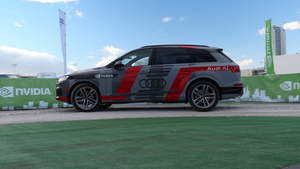LAS VEGAS, NV--(Marketwired - Jan 4, 2017) - CES -- NVIDIA (
Speaking at the opening keynote at CES, NVIDIA founder and CEO Jen-Hsun Huang, joined on stage by Audi of America President Scott Keogh, said future Audi car models will use deep learning to tackle the complexities of driving.
The first phase of this new collaboration focuses on NVIDIA DRIVE™ PX, an AI platform for self-driving cars, which uses trained AI neural networks to understand the surrounding environment, and determine a safe path forward.
"NVIDIA is pioneering the use of deep learning AI to revolutionize transportation," said Huang. "Audi's adoption of our DRIVE computing platform for AI cars will accelerate the introduction of next-generation autonomous vehicles, moving us closer to a future of higher driving safety and new mobility services."
Keogh said: "Audi drivers know the pinnacle of performance and technology. In our mutual pursuit for safer roads, the partnership between Audi and NVIDIA will expand to deep learning and artificial intelligence to bring higher automation onto the road more quickly."
One of the highlights of CES 2017 will be demos of an Audi Q7 piloted driving concept. Passengers will be able to ride in the vehicle's back seat, with no one behind the wheel.
Outfitted with a DRIVE PX 2 and running NVIDIA DriveWorks software, the Q7 uses deep neural networks -- specifically, NVIDIA PilotNet, which recognizes and understands its changing environment while driving safely. The course will be modified during the demonstration, and features a variety of road surfaces, with and without lane markings, and a simulated construction zone requiring a detour.
In his keynote, Huang addressed how AI will anticipate the driver's needs -- driving to the office in the morning and home at night, automatically opening and closing the garage door, and adjusting the climate to the individual's preferences, as well as being able to understand and respond to requests in a natural conversational language.
NVIDIA and Audi first appeared together at CES seven years ago and announced a technology partnership that has steadily expanded. The results include the award-winning Audi MMI navigation and the Audi virtual cockpit, currently available across a wide range of the automaker's sedans, SUVs and sports cars. In the coming months, Audi will roll out its new A8, the world's first Level 3 automated vehicle with its Traffic Jam Pilot system, powered by zFAS, which integrates NVIDIA hardware and software.
Keep Current on NVIDIA
Subscribe to the NVIDIA blog, follow us on Facebook, Google+, Twitter, LinkedIn and Instagram, and view NVIDIA videos on YouTube and images on Flickr.
About NVIDIA
NVIDIA's (
Certain statements in this press release including, but not limited to, statements as to: the timing of putting advanced AI cars on the road; future Audi car models using deep learning; the impact and benefits of DRIVE PX and Audi's adoption of the DRIVE computing platform; deep learning AI revolutionizing transportation; the Audi Q7 piloted driving demo; and the rollout of Audi's A8 are forward-looking statements that are subject to risks and uncertainties that could cause results to be materially different than expectations. Important factors that could cause actual results to differ materially include: global economic conditions; our reliance on third parties to manufacture, assemble, package and test our products; the impact of technological development and competition; development of new products and technologies or enhancements to our existing product and technologies; market acceptance of our products or our partners' products; design, manufacturing or software defects; changes in consumer preferences or demands; changes in industry standards and interfaces; unexpected loss of performance of our products or technologies when integrated into systems; as well as other factors detailed from time to time in the reports NVIDIA files with the Securities and Exchange Commission, or SEC, including its Form 10-Q for the fiscal period ended October 30, 2016. Copies of reports filed with the SEC are posted on the company's website and are available from NVIDIA without charge. These forward-looking statements are not guarantees of future performance and speak only as of the date hereof, and, except as required by law, NVIDIA disclaims any obligation to update these forward-looking statements to reflect future events or circumstances.
© 2017 NVIDIA Corporation. All rights reserved. NVIDIA, the NVIDIA logo and NVIDIA DRIVE are trademarks and/or registered trademarks of NVIDIA Corporation in the U.S. and other countries. Other company and product names may be trademarks of the respective companies with which they are associated. Features, pricing, availability and specifications are subject to change without notice.
Contact Information:
For further information, contact:
Fazel Adabi
PR Manager for Automotive
NVIDIA Corporation
(408) 486-8701
fadabi@nvidia.com
